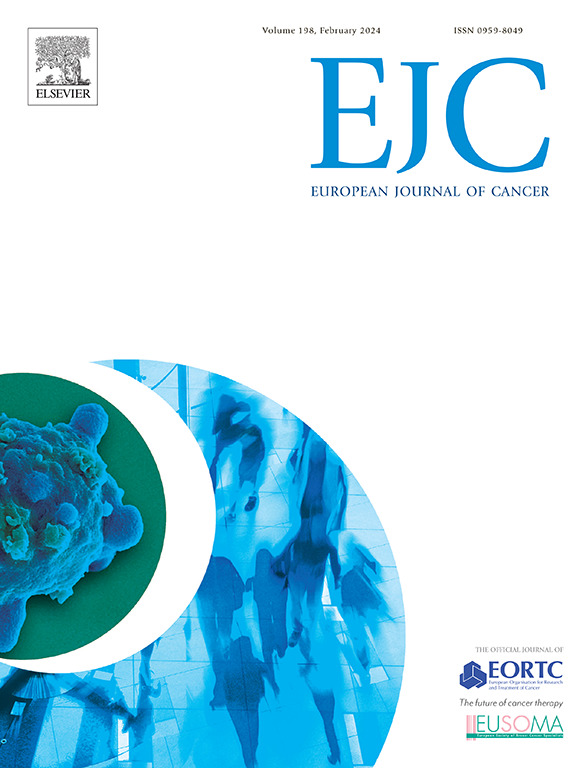Radiomic markers associated with clinical benefit in patients with radiographic progression of advanced uveal melanoma on tebentafusp
IF 7.6
1区 医学
Q1 ONCOLOGY
引用次数: 0
Abstract
Study aim
Tebentafusp, a bispecific fusion protein consisting of affinity-enhanced T cell receptor fused to anti-CD3 effector, has shown overall survival (OS) benefits across all RECIST response categories, including progressive disease (PD). In a phase 2 trial (NCT02570308) for advanced uveal melanoma (mUM), 35 % of PD patients experienced ≥ 0.5 log ctDNA reduction, resulting in a median overall survival (OS) of ∼17 months, compared to ∼8 months in the non-ctDNA reduction group.
Methods
A total of 34 of 127 2L+ mUM patients with PD were split into two groups based on absence or presence of ctDNA reduction (≥0.5 log reduction). Lesions from CT and MRI scans were analyzed using radiomics features at baseline and week eight, yielding two machine-learning-derived patient signatures (16 features). Performance of per-patient analysis (n = 32) and per-lesion analysis (n = 148) was assessed using ROC AUC (95 % confidence interval [CI]).
Results
In the per-patient analysis, a volumetric signature classified patients into groups with ROC AUC of 0.71 [0.53–0.90] with 63 % specificity and 81 % sensitivity at the optimal threshold (0.57). In the per-lesion analysis, a radiomic signature reached an ROC AUC of 0.70 [0.58–0.81] with 66 % specificity and 74 % sensitivity at the optimal threshold (0.53). Group B had lower baseline tumor lesion volume (ROC AUC=0.65), distinct baseline (ROC AUC=0.66), and change by week eight (ROC AUC=0.66/0.69 on CT/MRI) in tumor heterogeneity.
Conclusion
Radiomic analysis accurately predicted ctDNA reduction in PD patients at both the patient and lesion level. The most influential predictor was decreased tumor heterogeneity observed on CT/MRI.
放射组学标记与晚期葡萄膜黑色素瘤放射学进展患者的临床获益相关
tebentafusp是一种双特异性融合蛋白,由亲和力增强的T细胞受体与抗cd3效应物融合组成,在包括进展性疾病(PD)在内的所有RECIST反应类别中显示出总体生存(OS)益处。在一项针对晚期葡萄膜黑色素瘤(mUM)的2期试验(NCT02570308)中,35% %的PD患者经历了≥ 0.5 log的ctDNA减少,导致中位总生存期(OS)为~ 17个月,而非ctDNA减少组为~ 8个月。方法将127例2L+ mUM PD患者中34例根据ctDNA缺失或存在(≥0.5 log降低)分为两组。在基线和第8周使用放射组学特征分析CT和MRI扫描的病变,产生两个机器学习衍生的患者特征(16个特征)。采用ROC AUC(95 %置信区间[CI])评估每位患者分析(n = 32)和每位病变分析(n = 148)的表现。结果在每例患者分析中,体积特征将患者分为ROC AUC为0.71[0.53-0.90]的组,最佳阈值为63 %特异性和81 %敏感性(0.57)。在每个病灶的分析中,放射学特征的ROC AUC为0.70[0.58-0.81],在最佳阈值(0.53)下,特异性为66 %,敏感性为74 %。B组肿瘤病灶体积基线较低(ROC AUC=0.65),基线差异明显(ROC AUC=0.66),肿瘤异质性在第8周发生变化(CT/MRI ROC AUC=0.66/0.69)。结论放射组学分析可准确预测PD患者在患者和病变水平上的ctDNA减少。最具影响的预测因素是CT/MRI观察到的肿瘤异质性降低。
本文章由计算机程序翻译,如有差异,请以英文原文为准。
求助全文
约1分钟内获得全文
求助全文
来源期刊

European Journal of Cancer
医学-肿瘤学
CiteScore
11.50
自引率
4.80%
发文量
953
审稿时长
23 days
期刊介绍:
The European Journal of Cancer (EJC) serves as a comprehensive platform integrating preclinical, digital, translational, and clinical research across the spectrum of cancer. From epidemiology, carcinogenesis, and biology to groundbreaking innovations in cancer treatment and patient care, the journal covers a wide array of topics. We publish original research, reviews, previews, editorial comments, and correspondence, fostering dialogue and advancement in the fight against cancer. Join us in our mission to drive progress and improve outcomes in cancer research and patient care.
 求助内容:
求助内容: 应助结果提醒方式:
应助结果提醒方式:


